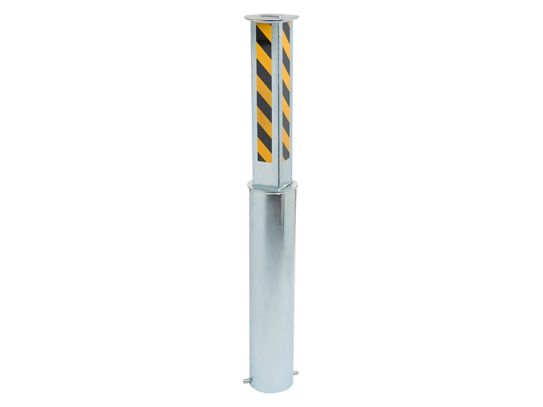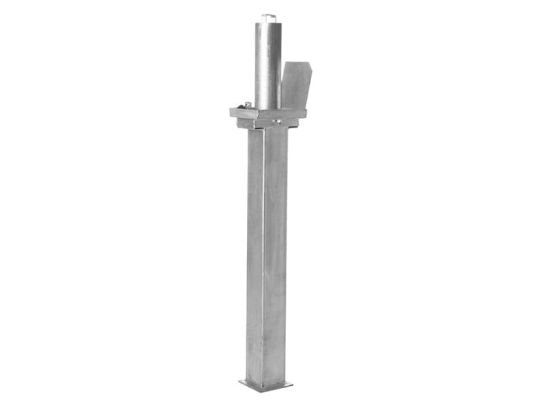Telescopic Parking Posts and Bollards
Looking for a reliable way to secure your driveway or parking space? Our telescopic parking posts are the answer. These sturdy bollards are made from durable steel and are designed to withstand the elements and any attempts at unauthorised access. With a key lock system, you can raise and lower the posts as needed, giving you complete control over who can enter your property.
Control Access to Your Property With Ease
Are you looking for a secure and reliable way to manage access to your driveway or parking space?Then look no further than our range of telescopic parking posts!
Made from sturdy galvanised steel, these parking posts are built to withstand the elements and any attempts at unauthorised access. With a simple key lock system, you can easily raise and lower the post as needed, giving you complete control over who can enter your property.
Don't let unwanted visitors take up valuable parking space on your property. Protect your private space with our telescopic parking posts. Order yours today!
What Are Telescopic Parking Posts?
Telescopic parking posts, also known as bollards or parking barriers, are devices that are used to block off a driveway or parking space. They are typically made of metal and are designed to be raised or lowered into the ground. When raised, the post creates a physical barrier that prevents vehicles from entering or exiting a designated area. Telescopic parking posts are often key lockable, allowing the owner to control access to the area. They are commonly used to protect private property, such as driveways and parking lots, from unauthorised access.
What Are Some Common Uses for Telescopic Parking Posts?
Telescopic parking posts are commonly used in a variety of settings to manage access to parking spaces and driveways. Some common uses for these devices include:
- Protecting private property: Telescopic parking posts can be used to prevent unauthorised vehicles from entering a driveway or parking lot.
- Managing access to restricted areas: These posts can be used to block off areas that are only accessible to authorised personnel, such as employee parking lots or restricted areas within a facility.
- Controlling traffic flow: Telescopic parking posts can be used to direct traffic in a specific direction or to block off certain areas to prevent confusion or accidents.
- Securing temporary events: These posts can be used to create a perimeter around a temporary event, such as a concert or festival, to control access and keep attendees safe.
- Enhancing security: In some cases, telescopic parking posts may be used to increase security at a facility by making it more difficult for vehicles to access certain areas.
What Are the Different Types of Telescopic Parking Posts?
There are several types of telescopic parking posts that are designed to meet different needs and applications. Some common types include:
- Manual telescopic parking posts: These posts are raised and lowered by hand using a crank or lever mechanism.
- Automatic telescopic parking posts: These posts are equipped with a motor that allows them to be raised and lowered automatically, typically using a remote control or key fob.
- Fixed telescopic parking posts: These posts are installed permanently in the ground and cannot be moved or removed.
- Removable telescopic parking posts: These posts can be easily removed and stored when not in use. They may be equipped with a lock or other security measure to prevent unauthorised removal.
- Surface-mounted telescopic parking posts: These posts are mounted on the surface of the ground, rather than being embedded in the ground.
- Subsurface-mounted telescopic parking posts: These posts are embedded in the ground, with only the top portion visible. When not in use, they can be lowered below the surface to allow vehicles to pass over them.
What Are the Key Features to Consider When Choosing Telescopic Parking Posts?
When choosing telescopic parking posts, there are several key features to consider, including:
- Material: Telescopic parking posts are typically made of metal, such as steel or aluminium. It's important to consider the durability and corrosion resistance of the material when making your selection.
- Size and weight: The size and weight of the parking post will determine how easy it is to install and move. Consider the size of the area you need to block off and choose a post that is appropriately sized.
- Lock system: If security is a concern, look for a parking post that is equipped with a secure lock system. This will prevent unauthorised removal of the post.
- Ease of use: Consider the ease of use when choosing a parking post. If you will be raising and lowering the post frequently, a manual post with a crank or lever mechanism may be more suitable. If you need a more convenient option, an automatic post with a remote control may be a better choice.
- Visibility: Make sure the parking post is visible enough to be seen by drivers. This will help prevent accidents and ensure that the post is effective at blocking off the designated area.
- Maintenance: Consider the maintenance requirements of the parking post. Some models may require more frequent cleaning or lubrication to keep them functioning properly.
How Do I Install a Telescopic Parking Post?
The process for installing a telescopic parking post will depend on the specific model you have and the installation method recommended by the manufacturer. In general, however, the following steps can be used as a guide:
- Choose a suitable location for the parking post. It should be located in a visible and easily accessible location, and should not obstruct traffic flow or create a safety hazard.
- Prepare the site for installation. This may involve removing any debris or vegetation, and levelling the ground if necessary.
- Assemble the parking post according to the manufacturer's instructions. This may involve attaching any necessary components, such as a base plate or mounting brackets.
- Install the parking post. This may involve digging a hole and setting the post in concrete, or using anchor bolts to secure the post to the ground.
- Test the post to ensure it is properly installed and functioning as intended. This may involve raising and lowering the post and testing the lock mechanism.
- If necessary, mark the location of the parking post with paint or other markers to make it more visible to drivers.
It's important to follow the manufacturer's instructions carefully when installing a telescopic parking post, as improper installation can compromise the security and functionality of the device. If you are unsure about the installation process, it may be best to consult a professional.
How Do I Maintain a Telescopic Parking Post to Ensure It Is Working Properly?
Proper maintenance is important to ensure that your telescopic parking post is functioning properly and will last for a long time. Here are some steps you can take to maintain your parking post:
- Keep the post clean: Dirt and debris can accumulate on the post over time, which can interfere with its operation. Use a soft cloth or brush to remove any dirt or debris that has accumulated on the post.
- Lubricate the post: Depending on the model, you may need to lubricate the post to keep it operating smoothly. Follow the manufacturer's recommendations for the type of lubricant to use and how often to apply it.
- Check the lock mechanism: Make sure the lock mechanism is functioning properly and is not damaged. If necessary, replace any worn or damaged parts to ensure the post can be locked securely in place.
- Inspect the post regularly: Inspect the post regularly for any signs of wear or damage, such as dents or scratches. If any damage is found, take steps to repair or replace the post as necessary to ensure it is functioning properly.
- Follow the manufacturer's recommendations: Make sure to follow the manufacturer's recommendations for maintenance and care of the parking post. This will help ensure that the post is operating at its best and will last for a long time.
What Safety Considerations Should Be Taken Into Account When Using Telescopic Parking Posts?
Telescopic parking posts can be useful tools for managing access to driveways and parking spaces, but it's important to consider safety when using these devices. Here are a few safety considerations to keep in mind:
- Visibility: Make sure the parking post is visible to drivers, especially at night. This can be achieved by using reflective tape or other markings on the post.
- Traffic flow: Do not place the parking post in a location that will obstruct traffic flow or create a safety hazard.
- User safety: When raising and lowering the parking post, be sure to follow any safety precautions outlined in the manufacturer's instructions. This may include using protective gear or maintaining a safe distance from the post.
- Maintenance: Regularly inspect and maintain the parking post to ensure it is in good working order. If the post is damaged or not functioning properly, it can pose a safety hazard.
- Unauthorised access: Do not allow unauthorised individuals to raise or lower the parking post. This can create a safety hazard and compromise the security of the area.
By following these safety considerations, you can help ensure that your telescopic parking post is used safely and effectively.
Are There Any UK or European Industry Standards That Apply to Telescopic Parking Posts?
There are several UK and European industry standards and regulations that apply to telescopic parking posts. In the UK, these standards are generally developed by the British Standards Institution (BSI), a non-profit organisation that develops and publishes standards for a wide range of products and services.
- One relevant standard in the UK is BS EN 12841:2006, which covers the safety requirements for fixed, manually operated road restraint systems. This standard applies to parking posts and other devices that are used to block off roads or other areas to prevent the passage of vehicles. It covers issues such as design and construction, performance requirements, and testing and marking requirements.
- In Europe, the relevant standard is EN 1317-2:2018, which covers the performance requirements for road restraint systems and pedestrian restraint systems. This standard applies to a wide range of devices, including parking posts, that are used to block off roads or other areas to prevent the passage of vehicles.
It's important to note that these standards are minimum requirements and that it is the responsibility of the manufacturer or supplier to ensure that their products meet these requirements. It's always a good idea to check with the manufacturer or supplier to make sure that the parking post you are considering meets the appropriate standards and regulations.

